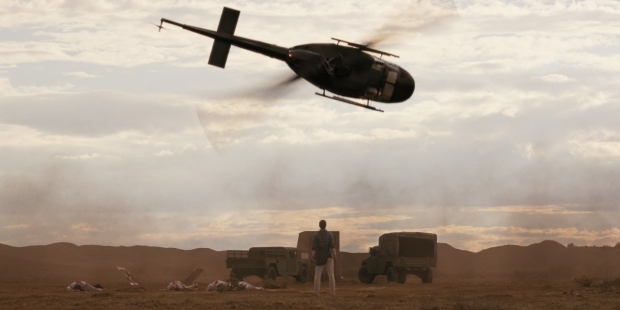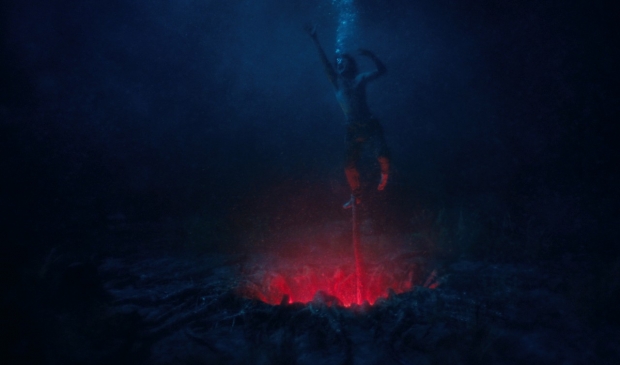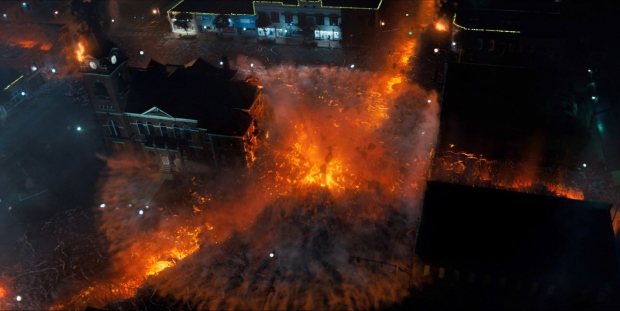Scanline used a digital replica of the Creel House to animate the vines and match the actors on-set performances for the moment that the vines grab hold and pin them to the wall. On-set elements helped to integrate the CG vines in the scene and V-Ray ensured realistic shadows and reflections, perfectly integrating with the practical effects.
“Chapter Vine”





“The vines are in many shots that are part of the Upside Down,” noted Mitchell. “Most of them are created and dressed by the art department, but in this sequence, they needed to really move.”
For Chapter Nine, Scanline added CG vines inside the creepy Creel House that come alive, animating their interaction with the actors and adding FX spores, dust, and atmos to emphasize the eerie atmosphere.
“Rifts Apart”




“Black Hawkins Down”
“One Big Disintegration”
Scanline put V-Ray’s capabilities through its paces, starting with the build of a full 3D replica of the Rainbow Room and a digital double of One. Performances were matched with that of the actor and stunt professional. One’s digital double contained a full series of bones and internal organs.
In Chapter Eight, Eleven makes a superpowered escape from Dr. Brenner’s shady laboratory and the attacking military forces after being drawn into a trap. Eleven uses her newly restored powers to bring a helicopter crashing down outside the facility.
The Upside Down is characterized by its unearthly atmosphere and the sequence was made more difficult by the kids’ flashlight beams intersecting with various atmospherics. Scanline layered elements in front and behind the volumetric light emanating from the flashlights using V-Ray’s light and atmospheric tools. Several shots across the season needed as many as a hundred render passes, which was accomplished in a practical time frame using V-Ray’s denoiser.
Chapter Seven builds to a critical moment in the story of Stranger Things when a young Eleven stands up to the villainous One in the Rainbow Room of Hawkins Lab. The superpowered face-off ends when Eleven throws One through a window and causes his body to erupt in a maelstrom of ash and light, creating the first rift, a nightmarish portal to the Upside Down.
“We had to devise a visual representation that was more dynamic, which is why we’ve got these two facing waterfalls that tear across the lake,” said Mitchell.
Netflix’s global phenomena, Stranger Things Season 4, garnered a record 1.15 billion viewing hours, with viewers tuning in to experience the excitement of the series’ signature scenes that included superpowered showdowns, exploding helicopters, and sinister vine attacks – many of which were created by Scanline VFX using V-Ray for rendering.
Scanline added and animated the CG helicopter, using V-Ray to create a cinematic spectacle as it spirals down.
This kind of effects-heavy sequence presents challenges to rendering resources. However Scanline tapped V-Ray, making use of the denoiser to get shots through the pipeline efficiently, achieving renders in a practical timeframe, with 220 shots delivered across eight episodes of television.
“The visual effects work in previous seasons was stellar, but this season was more like nine blockbuster movies,” said Justin Mitchell, VFX Supervisor at Scanline VFX. “We were given some huge sequences and complex effects to work on across eight of the episodes.”
In Chapter Nine, Scanline was called to create the most complex rift of the season. As rifts carve their way across Hawkins, one opens at the bottom of Lover’s Lake. The real-world effect of this event would likely be much like emptying a bath.
Source: Scanline VFX




Debbie Diamond Sarto is news editor at Animation World Network.




Houdini’s procedural generation tools took care of tearing the detailed mesh into discrete particles as One’s body dissolves into ash and light. V-Ray quickly and efficiently rendered the sequence’s physically accurate effects, meaning Scanline could render multiple lighting passes and extra textures, allowing them to deliver interactive lighting that created a burning effect as One disintegrates.
The new season picked up eight months after Season 3, with the series’ heroes separated for the first time, a situation made more difficult by the complexities of high school, a sinister new supernatural threat, and revelations about Eleven’s origins. Scanline had a hand in many of the season’s most exciting moments, with the climactic events of Chapters Seven, Eight, and Nine forming the bulk of the work.
With V-Ray’s speed, Scanline was able to iterate with different levels of subsurface on the CG vines. However, in the end, a decision was made to scale back and balance a slimy, organic feel with the look of the physical vines on set.
Scanline used various 3D tricks to execute these shots, using a cocktail of rigid bodies, cloth, soft bodies, fluids, hair, and particles to visualize doorways.
“I love V-Ray,” continued Mitchell, “as it’s our renderer of choice. Whether we’re working on huge superhero movies or high-concept TV shows, we can always count on its power and stability.”
“V-Ray has a lot of great advanced features,” concluded Mitchell, “but what you really want is a renderer that’s robust, fast, and just works. That’s definitely the case for V-Ray.”
“I don’t know how much of that appears in the final image, but you get a sense of the volume,” added Mitchell, “I wanted it to be volumetric and not simply a shell tearing into an empty space.”
A helicopter was filmed for the sequence but needed to be added digitally in about half the shots. CG was used to create the impact and explosion without crashing the actual helicopter. An on-set fireball gave the crash an explosive presence and provided a practical element for Scanline to build on for the rest of this big-screen sequence. Artists created a digital double of the real helicopter and the military Humvees and trucks that it would crash into on the ground. Digital fireballs and debris were added to further augment the explosion alongside the crumpling helicopter’s sparks, dust, and rotor wash.
Stranger Things Season 4 sees various rifts open across Hawkins, shattering the barrier between our world and the nightmarish realm of the Upside Down. It’s a defining moment for the show, with the threat level expanding to a new height, with Scanline’s VFX challenged to bring the sense of danger to the screen.

“There are so many rifts this season, appearing at different scales, in different materials and environments,” explained Mitchell. “We had to develop a common language between them.”







